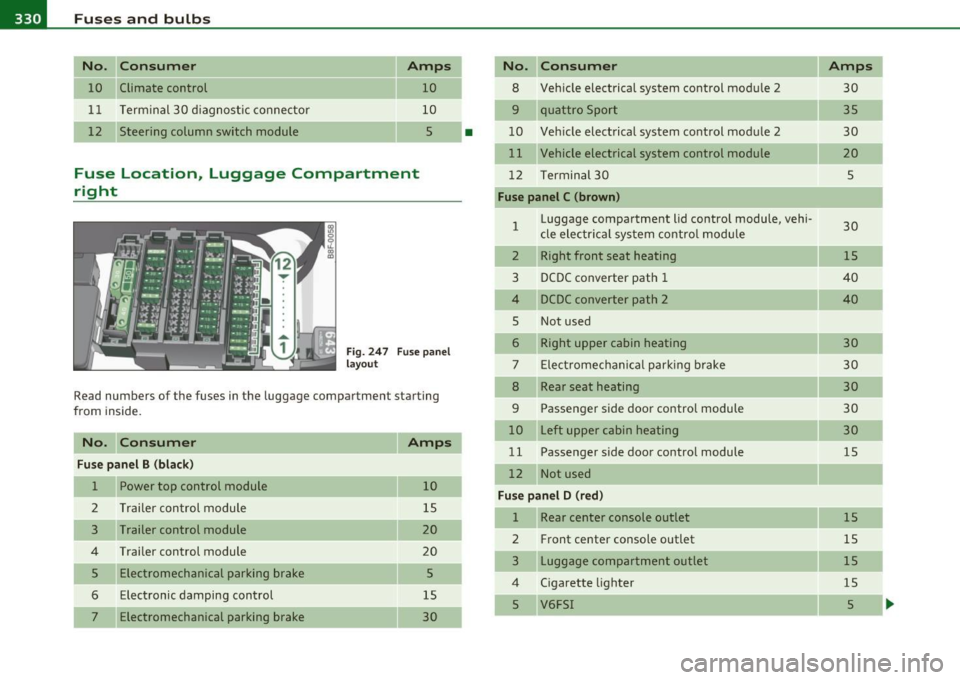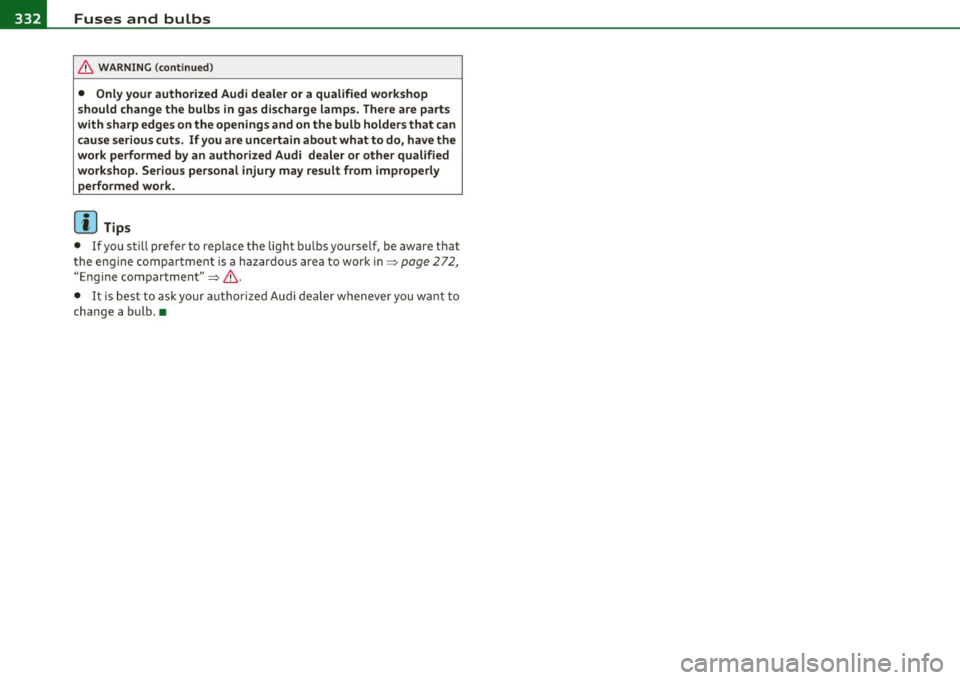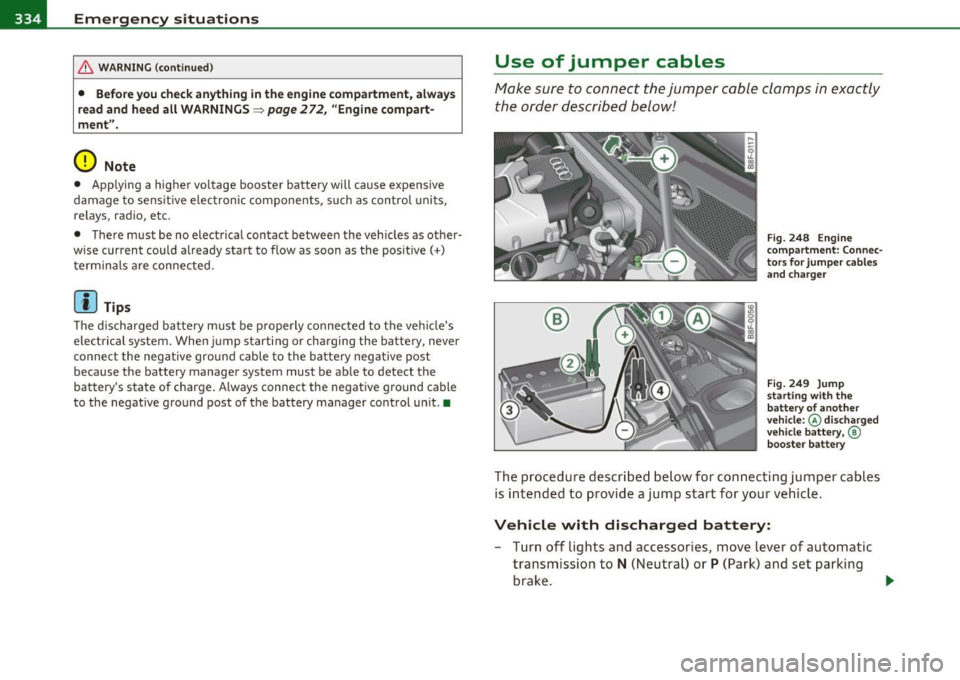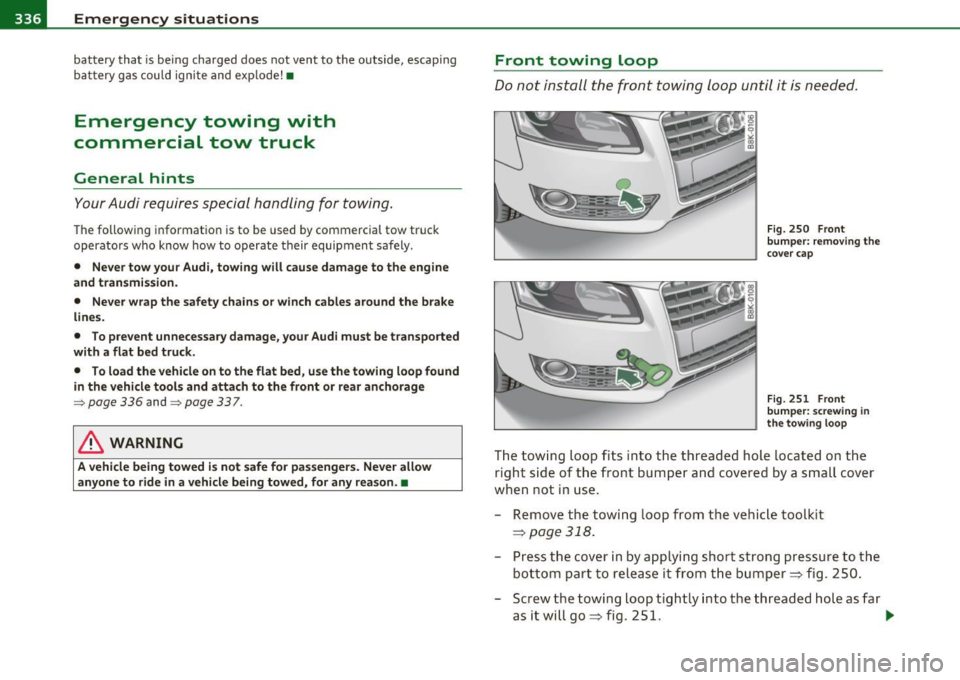AUDI A5 CABRIOLET 2010 Owners Manual
Manufacturer: AUDI, Model Year: 2010, Model line: A5 CABRIOLET, Model: AUDI A5 CABRIOLET 2010Pages: 364, PDF Size: 86.51 MB
Page 331 of 364

______________________________________________ F _u_s _e_ s_ a_ n_ d _ b _u_l_b _ s _ ___.ffl'I
No. Consumer Amps
5 Not used
6 Veh
icle electrical system control mod ule 1 35
7 Vehicle electrical system control module 1 20
8 Vehicle electrical system control modu le 1
30
9 Left rear window regulator motor 7,5
10 Veh icle electrical system co ntrol mod ule 1
30
Right rear window regulator motor 7,5
1 2 Convenience e lec tro nics 5
Fuse Location, Instrument Panel right
Fig. 24 6 Fus e p anel
lay out
Some of the equ ipment items l isted are optio nal or only avai lab le on
certain mode l configurations.
Note that the following table is a ccurate at the time of going to
p re ss and is sub ject to change. In the ev ent of discr epancie s, the
label on the in side of the co ver alwa ys takes pre cedence.
T he power seats are p rote cted by cir cuit breaker s, which a utomat i
cally reset after a few seconds after the over load has been remedied.
•
Vehicle OP-eration
No. Consumer Amps
Fuse panel (black )
1 Not used
2 Not used
3 Not used
4 Not used
5 Steering column switch module
s
6 Electronic Stabilization Program 5
7 Terminal 15 diagnostic connecto
r 5
8 Gateway (Databus diagnostic interface) 5
9 Not used
1 0 Not used
11 Not used
12 Not used
Fuse panel (brown)
1 C D-/DVD player 5
2 Audi drive select switch module 5
3 MMI/Radio
5/20
4 Instrument cluster 5
5
Gateway (instrument cluster control module) 5
6 Ignition lock 5
7 Rotary light switch
5
8 Climate control system blower 40
9 S teering column lock
5
Vehicle care Do-it-yourself service iTechnical data
Page 332 of 364

.,.,___F_ u_ s_e _ s_ a_n_d _b_u _ l_ b_s _______________________________________________ _
No. Consumer Amps
10 Climate control 10
11 Terminal 30 diagnostic connector 10
12 Steering column switch module 5
Fuse Location, Luggage Compartment
right
Fig. 247 Fuse panel
layout
Read numbers of the fuses in the luggage compartment starting
from inside.
No. Consumer
Fuse panel B (black)
1 Power top control module
2 Trailer control module
3 Trailer control module
4 Trailer control module
5 Electromechanical parking brake
6 Electronic damping control
7 Electromechanical parking brake
Amps
10
15
20
20 5
15
30
•
No. Consumer
8 Vehicle electrical system control module 2
9 quattro Sport
10 Vehicle electrical system control module 2
11 Vehicle electrical system control module
12 Terminal 30
Fuse panel C (brown)
1
2
3
4
Luggage compartment lid control module, vehi
cle electrical system control module
Right front seat heating
DCDC converter path 1
DCDC converter path 2
5 Not used
6 Right upper cabin heating
7 Electromechanical parking brake
8 Rear seat heating
9 Passenger side door control module
10 Left upper cabin heating
11 Passenger side door control module
12 Not used
Fuse panel D (red)
1 Rear center console outlet
2 Front center console outlet
3 Luggage compartment outlet
4 Cigarette lighter
5 V6FSI
Amps
30
35
30
20 5
30 15
40
40
30
30
30
30
30 15
15
15
15
15 5
Page 333 of 364

Fuses and bulbs -________________ Ef"I
No. Consumer
6 Rear Seat Entertainment supply
7 Parking system
8 Not used Electromechanical park ing brake switch
1 0 Aud i side assist
11 Rear sea t heating
12 Terminal 15 control modules
Fuse panel E (black)
1 Not used
2 Not used
3 DSP amplifier, radio
4 M MI
5 Radio/navigation/cell phone prep
6 Rearview c
amer a
7 No t used
8 Not used
9 Not use d
10 Not used
11 N
ot used
1 2 N ot used
Safety first
Amps
5
7,5
5
5
5
5
20/ 30
7,5
7,5
5
•
Bulbs
Replacing bulbs
F or your safety, we recommend that you have your autho
ri zed Audi dealer replace any bulbs for you.
It is becoming increasingly more and more diff icult to rep lace vehicle
ligh t bulbs since in many cases, other parts o f the car must fi rst be
removed before yo u are able to get to the bulb . This applies especially
to the light bu lbs in the front of your car which you can on ly reach
throug h the engi ne compartment .
Sheet meta l and bu lb holders can have sharp edges that can ca use
ser ious cuts, parts must be co rrectly t aken ap art and the n properly
put back together to he lp prevent breakage of parts and long term
d am age fro m water t hat c an enter housings that have no t been p rop
erly resea led.
For your safety, we recommend that you have you r authorized Audi
dealer replace any bulbs fo r you, since yo ur dealer has t he p roper
too ls, the correct bu lbs and the expertise.
Gas discharge lamp s (Xenon light s)* :
Due to the high electr ica l voltage , have the bulbs replaced by a qual
ified technicia n. Hea dlights w ith Xenon light are ident ified by the
high voltage sticker .
& WARNING
Changing Xenon lamps w ithout the necessary equipment can
cause serious personal injury.
• Bulbs are pressur ized and can explode when being changed.
Potential risk of injury !
• On vehicles equipped with gas discharge bulbs (Xenon light )*
lif e-threatening injurie s can re sult from improper handling of the
high- voltage port ions of such lamps ! .,_
Vehicle care Do-it-yourself service Technical data
Page 334 of 364

-Fuses and bulbs Pf":I..._ ______________ _
& WARNING (continued)
• Only your authorized Audi dealer or a qual ified workshop
should change the bulbs in gas discharge lamps. There are parts
with sharp edges on the openings and on the bulb holders th at can
cause serious cuts . If you are uncertain about what to do, have the
work performed by an authorized Audi dealer or other qualified
workshop . Serious personal injury may re sult from improperly
perfo rmed work.
[ i ] Tips
• If you still prefer to rep lace the light bu lbs yourself, be aware that
t he engine comp artme nt is a haza rdous area to work in =>
page 272,
"Eng ine compartment"=> &.
• It is best to ask yo ur autho riz e d Au di d ealer w henever you w ant to
change a bulb. •
Page 335 of 364

Emergency situations --------------=----Efffll
Emergency situations
General
This chapter is intended for trained emergency crew s and working
personnel who ha ve the necessar y tools and equipment to perform
the se operations . •
Starting by pushing or towing
(D Note
Vehicles with an automatic transmis sion cannot be started by
pushing or towing .•
Starting with jumper cables
If necess ary, the engine can be started by connecting it to
the battery of an other vehicle .
If the engine shou ld fai l to start because of a discharged or weak
battery, t he battery can be co nnecte d to the battery of
another
vehicle, using a pair of jumper cable s to start the engine .
Jumper cables
Use only jumper cables of suffic ient ly large cross section to carry the
sta rter cur ren t safely . Refe r to the manufacture r's specifications.
Use on ly j umper cab les with
insulated te rm ina l clamps w hich are
distinct ly marked :
plus(+) cable in most cases colo red red
minus (-) cable i n most cases colored black.
Safety first
& WARNING
Batterie s contain electricity, acid, and gas . Any of these can cause
very serious or fatal injury . Follow the inst ructions below for safe
handling of your vehicle 's battery .
• Always shield your eyes and avoid leaning over the battery
whenever possible.
• A discharged battery can freeze at temperatures just below
32 °F (0 °C). Before connecting a jumper cable, you must thaw the
frozen battery completely , otherwise it could explode.
• Do not allow battery acid to contact eyes or skin . Flush any
contacted area with water immediately .
• Improper use of a booster battery to start a vehicle may cause
an e xplosion.
• Vehicle batteries generate e xplos ive gases. Keep spa rks, flame
and lighted cigarettes away from batteries.
• Do not try to jump start any vehicle with a low acid level in the
battery.
• The voltage of the booster battery must also h ave a 12 -Volt
rating. The capacity (Ah) of the booster battery should not be
lower than that of the discharged battery. Use of batter ies of
different voltage or sub stantially different "Ah " rating may cau se
an explosion and personal injury.
• Never charge a frozen battery . Ga s trapped in the ice may cause
an e xplosion.
• Never charge or use a battery that has been frozen. The battery
case may have be weakened.
• Use of batteries of different voltage or substantially different
capacity (Ah ) rating may cause an explosion and injury . The
capacity (Ah ) of the booster battery should not be lower than that
of the discharged battery. _..
Vehicle care Do-it-yourself service Technical data
Page 336 of 364

,..,___E_ m_ e_r -=g :.. e_ n_c -=y '-- s_i_t _u _a _ t_ i_ o _ n_ s ____________________________________________ _
& WARN ING (con tin ue d)
• Before you che ck anything in the engine compartment, always
read and heed all WARNINGS~
page 272, "Engine compart
ment ".
0 Note
• App lying a higher vo ltage booster battery will cause expens ive
damage t o sens it ive e lec tron ic compone nts, such as contro l units,
re lays, rad io, etc.
• The re must be no elect rical contact between the veh icles as othe r
w ise current could already start to flow as soon as the pos it ive( +)
t erminals a re connected.
[ i ] Tips
Th e d ischarged ba ttery mus t be p roper ly connec ted to t he veh icle's
electrical system. When jump starting or charging the battery , never
conne ct the negative grou nd ca ble to the ba ttery negative post
because the battery manager system must be ab le to detect the
ba ttery's state of charge. A lways connec t the negat ive g round cable
to the negative ground post of t he battery manager cont rol un it .•
Use of jumper cables
fvf ake sure t o con nect the j umpe r ca ble clam ps i n ex a ctly
the order describ ed belo w!
Fig. 248 Engine
comp artment : Co nnec
t o rs f or jump er cabl es
a nd c harger
Fig . 249 Jump
sta rtin g with the
b at tery of another
ve hicle :@ disc harge d
v ehicle battery ,©
bo oste r battery
The procedure descri bed below for con nec ting ju mper cables
is i nten ded to prov ide a jump start for your veh icle .
Vehicle with discharged battery:
-Turn off lights and accesso ries, move l ever of au to m atic
tra nsmi ssio n to
N (Ne utr al) or P (Park) an d se t parking
bra ke .
~
Page 337 of 364

Emergency situations Ill
-------------=----
Connect POSITIVE (+) to POSITIVE (+) (red)
- Remove the cover above the jump start connectio n.
- Open the red cover o n the positive pole~
page 334,
fig. 248.
1 . Connect one e nd of the pos it ive cable ( red) on the
jump
start bolt~
page 334, fig. 249 (D (Bolts under red cover
= "positive") of the veh ic le to be started @.
2 . Connect the other end to the positive te rminal @ of the
booster ba ttery @.
Connect NEGATIVE(-) to NEGATIVE(-)
(black)
3. Con nect o ne end to the negative ter minal ® of the
boost er batte ry @ .
4. Connect the other end o f the nega tive cab le (black) to the
jump start bolt© (Bolts with hex head = "ne gative") of
the vehicle to be starte d @ .
Starting the engine
- Start the e ngine of t he ve hic le w ith the boos ter ba ttery.
Run the engine at a moderate speed.
- Start eng ine w it h discharged ve hicle bat tery in t he usu al
manner .
- If the engine fai ls to sta rt: do not k eep the s tarter
c ra nki ng for longer tha n 1 0 seco nds. Wait for a bou t
30 se conds and then t ry again.
- With engine ru nni ng, remove jumper cables from bot h
ve hicle s in th e exac t
re verse ord er.
- Close t he red cover on the pos it ive po le.
Safety first
T he battery is vented to the outside to prevent gases from enter ing
t he ve hicl e inter ior. Make su re tha t the ju mper clamps are we ll
connected with the ir
metal parts in full contact with the battery
terminals .
& WARNING
To avoid serious personal injury and damage to the vehicle, heed
all warnings and instructions of the jumper cable manufacturer . If
in doubt, call for road service .
• Jumper cables must be long enough so that the vehicles do not
touch.
• When connecting jumper cables , make sure that they cannot
get caught in any moving part s in the engine compartment .
• Do not bend over the batteries · danger of chemical burns!
• The battery cell locking screws mu st be tightened securely .
• Before you che ck anything in the engine compartment, always
read and heed all WARNINGS=>
page 272, ''Eng ine compart
ment ".
0 Note
Imprope r hoo k-up o f jumpe r cab les can ruin the gene rator.
• Always connect POSITIVE( +) to POSITIVE(+), and NEGATIVE( -)
t o NEG ATI VE( -) ground pos t of the ba tte ry m anag er cont rol unit.
• Check that all sc rew p lugs on the battery cells are screwed in
fi rm ly . If no t, tig hten plugs prio r to con nectin g clamp on neg ative
battery terminal.
• P lease note that the proced ure for connecting a jumper cable as
described above app lies specifically to the case of your vehicle being
jum p st arted. When you a re giving a jump sta rt to anot her vehicle, do
not connect the negative( -) cab le to the negative (-) terminal on the
discharge d batte ry © =>
page 334, fig. 249 . Instea d, sec urely
connect the negative( -) cable to either a solid meta l component t hat
is f irm ly bolted to t he eng ine b lock or to the eng ine b lock itself. If the .,_
Vehicle care Do-it-yourself service Technical data
Page 338 of 364

lffll.,___E_ m_ e_r-=g :.. e_ n_c -=y '-- s_i_t _u _a _ t_ i_ o _ n_ s ____________________________________________ _
battery that is being charged does not vent to the outside, escaping
battery gas could ignite and explode! •
Emergency towing with
commercial tow truck
General hints
Your Audi requires special handling for towing.
The following information is to be used by commercial tow truck
operators who know how to operate their equipment safely.
• Never tow your Audi, towing will cause damage to the engine
and transmission.
• Never wrap the safety chains or winch cables around the brake
lines.
• To prevent unnecessary damage, your Audi must be transported
with a flat bed truck.
• To load the vehicle on to the flat bed, use the towing loop found
in the vehicle tools and attach to the front or rear anchorage
~ page 336 and ~ page 33 7.
& WARNING
A vehicle being towed is not safe for passengers. Never allow
anyone to ride in a vehicle being towed, for any reason. •
Front towing loop
Do not install the front towing loop until it is needed.
Fig. 250 Front
bumper: removing the
cover cap
Fig. 251 Front
bumper: screwing in
the towing loop
The towing loop fits into the threaded hole located on the
right side of the front bumper and covered by a small cover
when not in use.
- Remove the towing loop from the vehicle toolkit
~page 318.
- Press the cover in by applying short strong pressure to the
bottom part to release it from the bumper~ fig. 250.
- Screw the towing loop tightly into the threaded hole as far
asitwillgo~fig. 251. ..,
Page 339 of 364

_____________________________________________ E_ m __ e_r-=g =- e_ n_c -==y "- s_i_ t _u _a _ t_ i_ o _ n_ s _ __.lfll
When it is no longer needed, unscrew the towing loop and put it back
into the vehicle toolkit. Be sure to have the towing loop stored in the
vehicle at all times.
& WARNING
If the towing loop is not screwed in as far as it will go, the thread
can pull out when the vehicle is towed -potential risk of an
accident. •
Rear towing loop
Do not install the rear towing loop until it is needed.
Fig. 252 Rear
bumper: Screwing in
towing loop
On the right side of the rear bumper there is a threaded hole
for the towing loop. The threaded hole is protected by a
cover.
- Remove the towing loop from the vehicle toolkit
=> page 318.
- Press the cover in by applying short strong pressure to the
bottom part to release it from the bumper :::::;, fig. 252.
- Screw the towing loop tightly into the threaded hole as far as it will go .
Vehicle OP-eration
Unscrew the towing loop again after use and install the cover in the
bumper. Install the cover in the bumper. Return the towing loop to
the toolkit . Be sure to have the towing loop stored in the vehicle at all
times.
& WARNING
If the towing loop is not screwed in as far as it will go, the thread
can pull out when the vehicle is towed -potential risk of an
accident. •
Loading the vehicle onto a flat bed truck
Front hook up
0 0
;
Fig. 253 Vehicle on
flat bed truck
- Align the vehicle with the centerline of the car carrier
ramp.
- Attach the winch hook to the front towline eye previously
installed.
Rear hook up
- Align the vehicle with the centerline of the car carrier
ramp.
Vehicle care Do-it-yourself service iTechnical data
Page 340 of 364

III...__E_ m_ e_r-=g :.. e_ n_c -=y '-- s_i_t _u _a _ t_ i_ o _ n_ s ____________________________________________ _
-Attach the winch hook to the rear towline eye previously
installed.
[I) Tips
Check carefully to make sure the hook-up is secure before moving the
car up the flatbed truck ramp.•
Lifting vehicle
Lifting with workshop hoist and w ith floor
jack
The vehicle may only be lifted at the lifting points illus
trated.
Fig . 254 Front lifting
point
- Read and heed WARNING~ &.
Fig. 255 Rear lifting
point
-Locate lifting points~ fig. 254 and~ fig. 255.
- Adjust lifting arms of workshop hoist or floor jack to
match vehicle lifting points.
- Insert a rubber pad between the floor jack/workshop hoist
and the lifting points.
If you must lift your vehicle with a floor jack to work underneath,
be sure the vehicle is safely supported on stands intended for this
purpose.
Front Lifting point
The lifting po int is located on the floor pan re inforcement about at
the same level as the jack mounting point=> fig. 254.
Do not lift the
vehicle at the vertical sill reinforcement.
Rear lifting point
The lifting point is located on the vertical reinforcement of the lower
sill for the onboard jack=> fig . 255.
Lifting with vehicle jack
Refer to=> page 323.